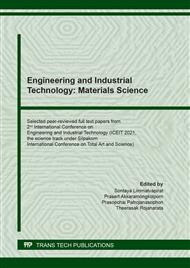[1]
Y.-C. Ah, J.-K. Choi, Y.-K. Choi, H.-M. Ki, J.-H. Bae, A novel transdermal patch incorporating meloxicam: In vitro and in vivo characterization, Int. J. Pharm. 385 (2010) 12-19.
DOI: 10.1016/j.ijpharm.2009.10.013
Google Scholar
[2]
R. Jantharaprapap, G. Stagni, Effects of penetration enhancers on in vitro permeability of meloxicam gels, Int. J. Pharm. 343 (2007) 26-33.
DOI: 10.1016/j.ijpharm.2007.04.011
Google Scholar
[3]
S. Noble, J.A. Balfour, Meloxicam, Drugs 51 (1996) 424-430.
Google Scholar
[4]
M.A. Ruiz Martinez, J. López-Viota Gallardo, M.M. de Benavides, J. de Dios García López-Duran, V. Gallardo Lara, Rheological behavior of gels and meloxicam release, Int. J. Pharm. 333 (2007) 17-23.
DOI: 10.1016/j.ijpharm.2006.09.045
Google Scholar
[5]
G. Yener, M. Üner, Ü. Gönüllü, S. Yildirim, P. Kiliç, S.S. Aslan, et al., Design of meloxicam and lornoxicam transdermal patches: Preparation, physical characterization, ex vivo and in vivo studies, Chem. Pharm. Bull. 58 (2010) 1466-1473.
DOI: 10.1248/cpb.58.1466
Google Scholar
[6]
D.A. Castilla-Casadiego, H. Carlton, D. Gonzalez-Nino, K.A. Miranda-Muñoz, R. Daneshpour, D. Huitink, et al., Design, characterization, and modeling of a chitosan microneedle patch for transdermal delivery of meloxicam as a pain management strategy for use in cattle, Mater. Sci. Eng. C. 118 (2021) 111544.
DOI: 10.1016/j.msec.2020.111544
Google Scholar
[7]
X.-D. Duan, C.-J. Ji, L. Nie, Formulation and development of dendrimer-based transdermal patches of meloxicam for the management of arthritis, Trop. J. Pharm. Res. 14 (2015) 583-590.
DOI: 10.4314/tjpr.v14i4.4
Google Scholar
[8]
M. Ferreira, R.J. Mendonça, J. Coutinho-Netto, M. Mulato, Angiogenic properties of natural rubber latex biomembranes and the serum fraction of Hevea brasiliensis, Braz. J. Phys. 39 (2009) 564-569.
DOI: 10.1590/s0103-97332009000500010
Google Scholar
[9]
H. Hasma, A. Subramaniam, Composition of lipids in latex of Hevea brasiliensis clone RRIM 501, J. Nat. Rubb. Res. 1 (1986) 30-40.
Google Scholar
[10]
P.B. Aielo, F.A. Borges, K.M. Romeira, M.C.R. Miranda, L.B.d. Arruda, P.N.L. Filho, et al., Evaluation of sodium diclofenac release using natural rubber latex as carrier, Mat. Res. 17 (2014) 146-152.
DOI: 10.1590/s1516-14392014005000010
Google Scholar
[11]
P. Boonme, W. Taweepreda, W. Pichayakorn, Novel process in preparation of deproteinized natural rubber latex, Adv. Mater. Res. 844 (2014) 462-465.
DOI: 10.4028/www.scientific.net/amr.844.462
Google Scholar
[12]
R.D. Herculano, A.A. Alencar de Queiroz, A. Kinoshita, O.N. Oliveira, C.F.O. Graeff, On the release of metronidazole from natural rubber latex membranes, Mater. Sci. Eng. C. 31 (2011) 272-275.
DOI: 10.1016/j.msec.2010.09.007
Google Scholar
[13]
J. Suksaeree, P. Boonme, W. Taweepreda, G.C. Ritthidej, W. Pichayakorn, Characterization, in vitro release and permeation studies of nicotine transdermal patches prepared from deproteinized natural rubber latex blends, Chem. Eng. Res. Des. 90 (2012) 906-914.
DOI: 10.1016/j.cherd.2011.11.002
Google Scholar
[14]
R. Waiprib, P. Boonme, W. Taweepreda, E. Kalkornsurapranee, J. Suksaeree, W. Pichayakorn, Deproteinized natural rubber latex/gelatinized starch blended films as drug delivery carrier, Monatsh. Chem. 148 (2017) 1223-1228.
DOI: 10.1007/s00706-017-2005-x
Google Scholar
[15]
W. Pichayakorn, H. Boontawee, W. Taweepreda, J. Suksaeree, P. Boonme, Physicochemical and drug release characterization of lidocaine-loaded transdermal patches prepared from STR-5L block rubber, Ind. Eng. Chem. Res. 53 (2014) 1672-1677.
DOI: 10.1021/ie403529f
Google Scholar
[16]
D. Patel, S.A. Chaudhary, B. Parmar, N. Bhura, Transdermal drug delivery system: A review, Pharma Innov. 1 (2012) 67-80.
Google Scholar
[17]
J. Suksaeree, W. Pichayakorn, C. Monton, A. Sakunpak, T. Chusut, W. Saingam, Rubber polymers for transdermal drug delivery systems, Ind. Eng. Chem. Res. 53 (2014) 507-513.
DOI: 10.1021/ie403619b
Google Scholar
[18]
W. Pichayakorn, J. Suksaeree, P. Boonme, W. Taweepreda, G.C. Ritthidej, Preparation of deproteinized natural rubber latex and properties of films formed by itself and several adhesive polymer blends, Ind. Eng. Chem. Res. 51 (2012) 13393-13404.
DOI: 10.1021/ie301985y
Google Scholar
[19]
I.P. Mahendra, M.K. Linh, N.N. Thang, V.T. Thuy, L.T. Trang, L.X. Thinh, et al., Protein removal from natural rubber latex with Fe3O4@Al2O3 nanoparticle, J. Braz. Chem. Soc. 32 (2021) 320-328.
DOI: 10.21577/0103-5053.20200182
Google Scholar
[20]
A. Singh, A. Bali, Formulation and characterization of transdermal patches for controlled delivery of duloxetine hydrochloride, J. Anal. Sci. Technol. 7 (2016) 25.
DOI: 10.1186/s40543-016-0105-6
Google Scholar
[21]
W. Pichayakorn, J. Suksaeree, P. Boonme, T. Amnuaikit, W. Taweepreda, G.C. Ritthidej, Nicotine transdermal patches using polymeric natural rubber as the matrix controlling system: Effect of polymer and plasticizer blends, J. Membr. Sci. 411-412 (2012) 81-90.
DOI: 10.1016/j.memsci.2012.04.017
Google Scholar
[22]
W. Simchareon, T. Amnuaikit, P. Boonme, W. Taweepreda, W. Pichayakorn, Properties of deproteinized natural rubber latex blended films with glycol penetration enhancers for pharmaceutical applications, Adv. Mater. Res. 747 (2013) 87-90.
DOI: 10.4028/www.scientific.net/amr.747.87
Google Scholar


